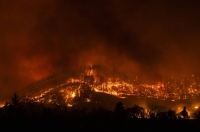Extreme heat from California’s climate-driven wildfires is transforming a metal common in soil into an airborne carcinogen that can be inhaled by firefighters and people living downwind of conflagrations, according to first-of-its-kind research.
In a study published Dec. 12 in the journal Nature Communications, Stanford University scientists discovered what they described as widespread and dangerous levels of toxic chromium in areas of Northern California severely burned by wildfires in 2019 and 2020.
"There are vast areas of these metal-rich geologies around the world with landscapes that are ready to burn, such as in Africa, Australia and Canada,” said Scott Fendorf, a professor of earth system science at Stanford University and an author of the paper.
Chromium is relatively ubiquitous: A benign form of the metal called chromium 3 exists in soils derived from chromium-laden rocks found on every continent. But as drought and heat waves prime forests and other wildlands to burn at higher temperatures for longer durations and over larger areas, chromium 3 is emerging as a growing threat.
"Chromium 6 (hexavalent chromium) is the most toxic known type of chromium, and is associated with a litany of significant health issues, such as skin and eye irritation, kidney and liver failure and lung cancer,” Kimberly Humphrey, a physician and fellow in climate change and human health at Harvard University, said in an email. Humphrey was not involved in the research. "This is an important study, and underscores the need for further research in this area — not only into chromium, but into the effect of fires on other heavy metals present in the soil.”
Australian scientists in 2019 reported that exposing chromium 3 to high temperatures in the laboratory changed the mineral into toxic hexavalent chromium, called chromium 6 (also known as the water contaminant in the 2000 blockbuster Erin Brockovich). The catastrophic wildfires that devastated huge tracts of Northern California in 2019 and 2020 gave the Stanford scientists an opportunity to test whether those lab results would be replicated in nature.
Researcher Alandra Marie Lopez, a Stanford postdoctoral scholar in Earth system science, collected soil and ash from burn sites with chromium-rich soil immediately after the fires were contained. She returned 11 months later for additional sampling. Lopez measured chromium 6 in soil particles small enough to become airborne and found high concentrations of the toxic metal, even after nearly a year had passed.
"We saw a lot of the hexavalent chromium just persisting in the surface layers of the soil,” said Lopez, the paper’s lead author. California was in the midst of a record drought then; without rain to wash away the contaminated soil, the chromium remained.
Edward Burton, a professor of environmental geochemistry and mineralogy at Southern Cross University in Australia, said that finding is significant. "Newly formed hexavalent chromium can persist in surface soil and ash for many months after wildfires, thereby presenting a health risk to those exposed to fine soil particles or ash,” Burton, who was not involved in the research, said in an email.
The researchers didn’t test for the presence of chromium 6 in the air, but the levels found in surface soil suggest the metal could threaten the safety of communities that have experienced wildfire. Firefighters and anyone living downwind of a wildfire would be at most immediate risk if chromium 6 becomes airborne. During a drought — when chromium 6 remains in the ground following a wildfire — any disturbance of the soil would pose a risk, including to workers who rehabilitate burn zones and people who return to recovering wildfire sites to hike and bike.
"This is of particular concern in the western USA because large areas of land are naturally rich in soil chromium and because wildfires appear to be increasing in severity and frequency due to climate change,” added Burton, who led the team that discovered the link between high temperatures and chromium 6.
Rain, like the deluges that broke California’s drought, prevents chromium 6 from lingering in burned areas. But it could cause other problems. "One of the things we’re really interested in exploring is the potential after a post-fire wet season for hexavalent chromium to be mobilized into surface water in burned areas,” said Lopez.
Fendorf noted that more research is also needed on the presence of chromium 6 in wildfire smoke, which already is a health hazard, as well as the potential of other metals found in soil, such as manganese and nickel, to turn toxic. The study’s findings underscore that people should protect themselves during wildfires by wearing protective masks, staying inside and installing air purifiers. He said more controlled burns to reduce fuel loads in forests would lower the intensity of wildfires and thus the volume of chromium 6 in soil.


















With your current subscription plan you can comment on stories. However, before writing your first comment, please create a display name in the Profile section of your subscriber account page.